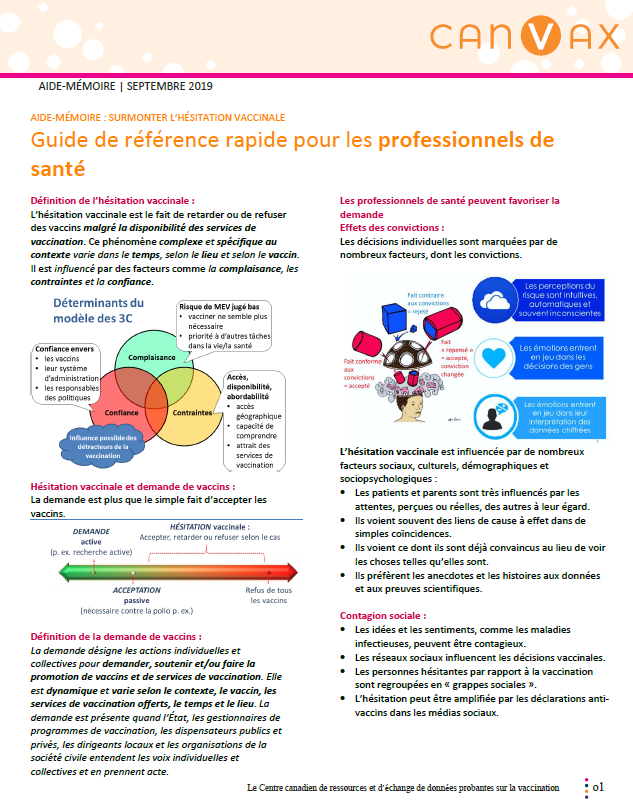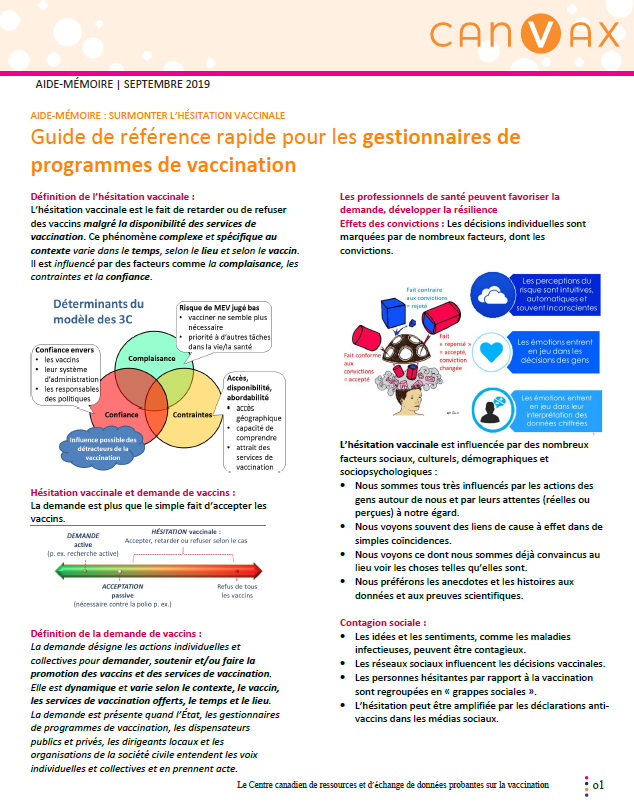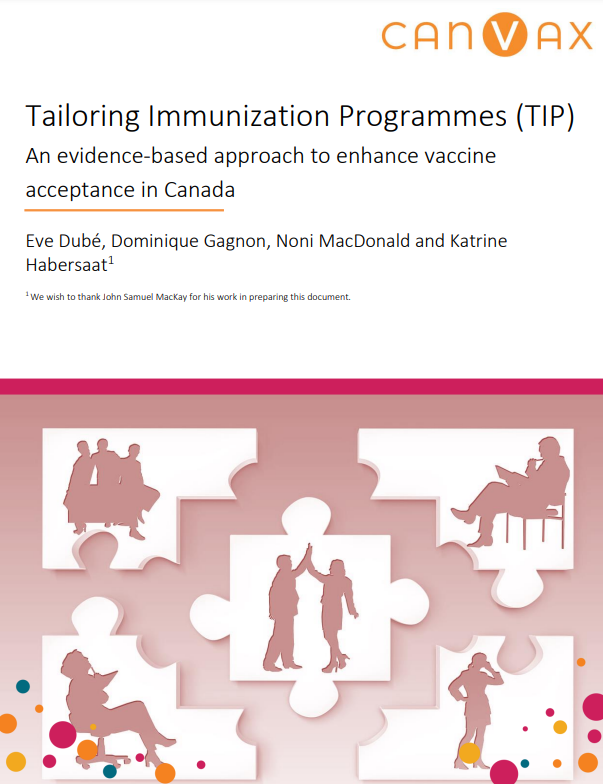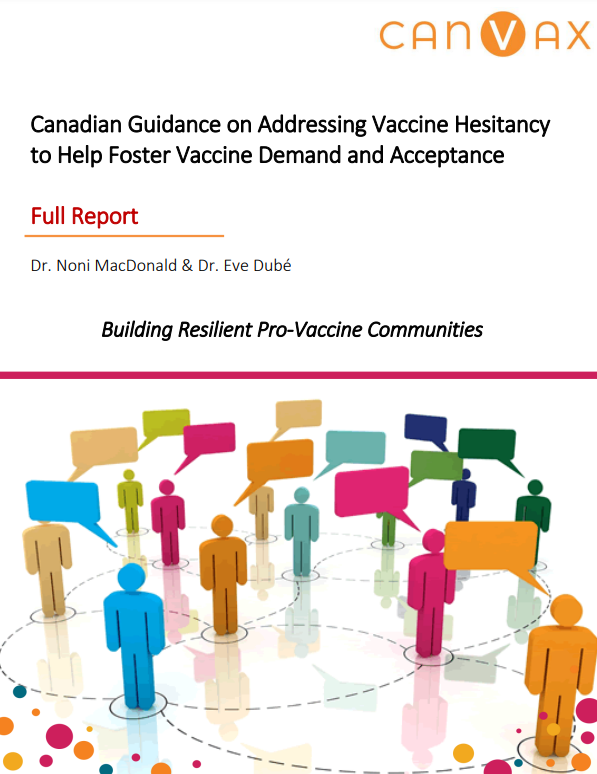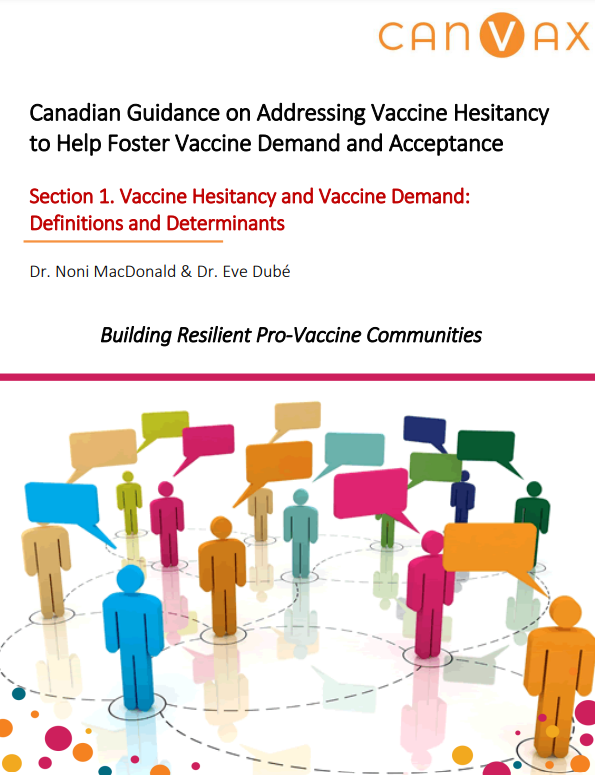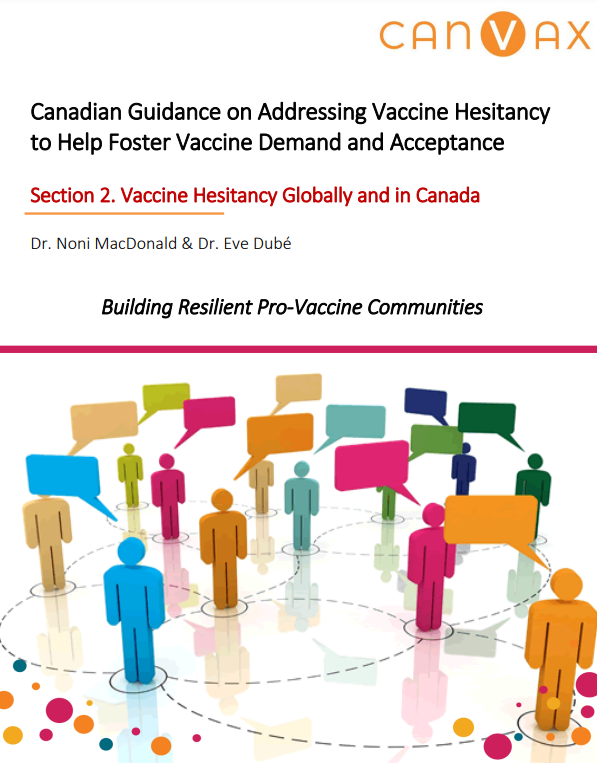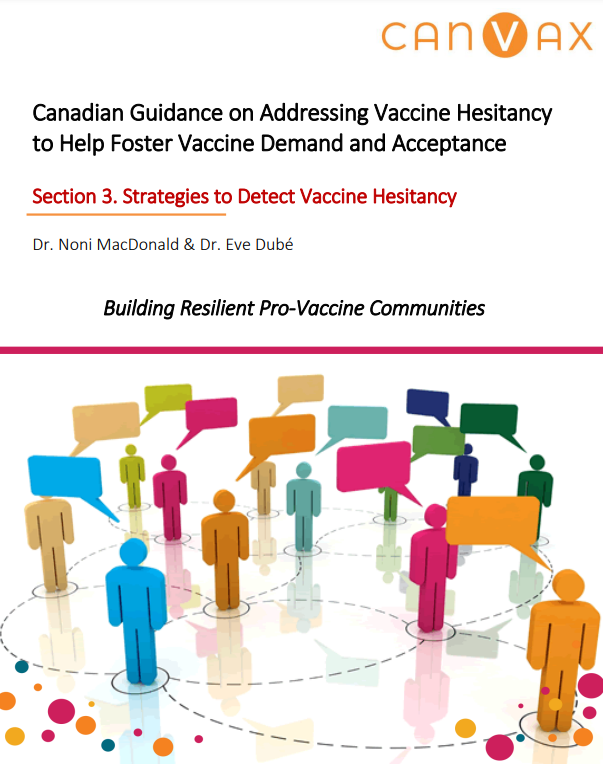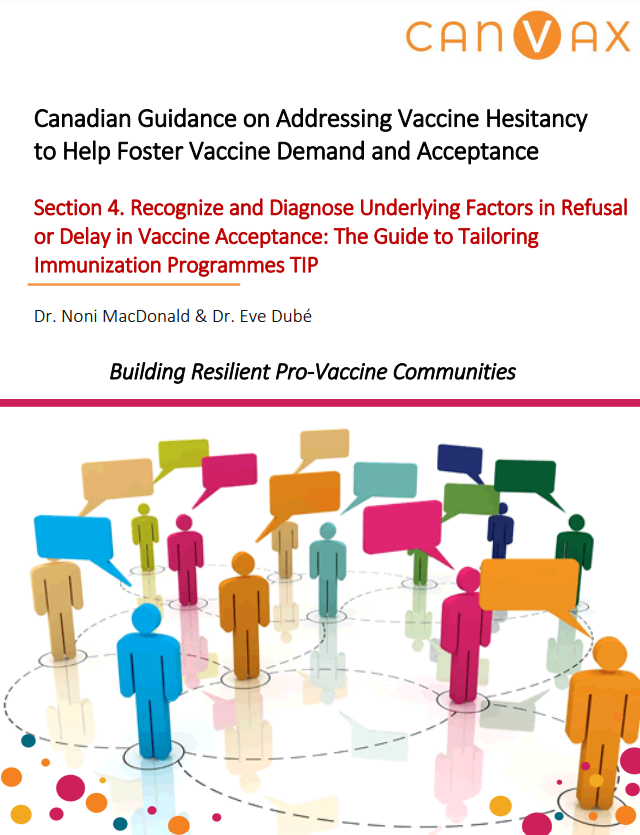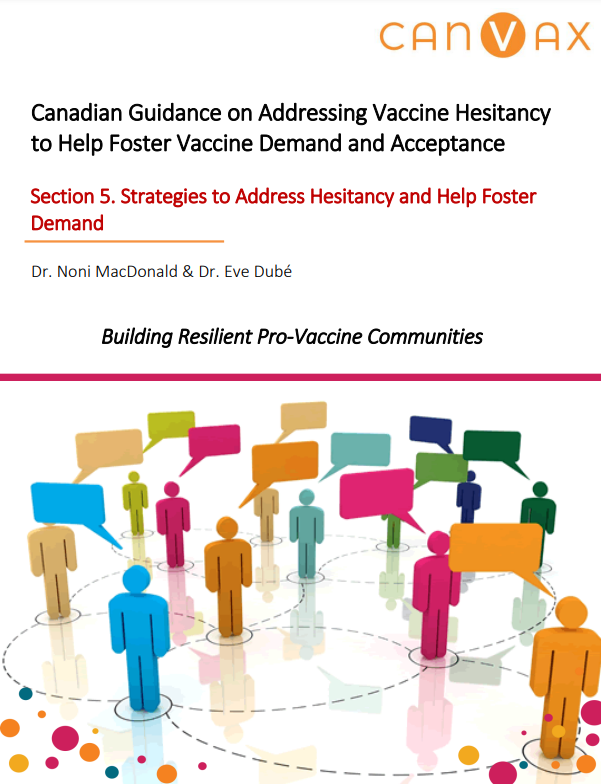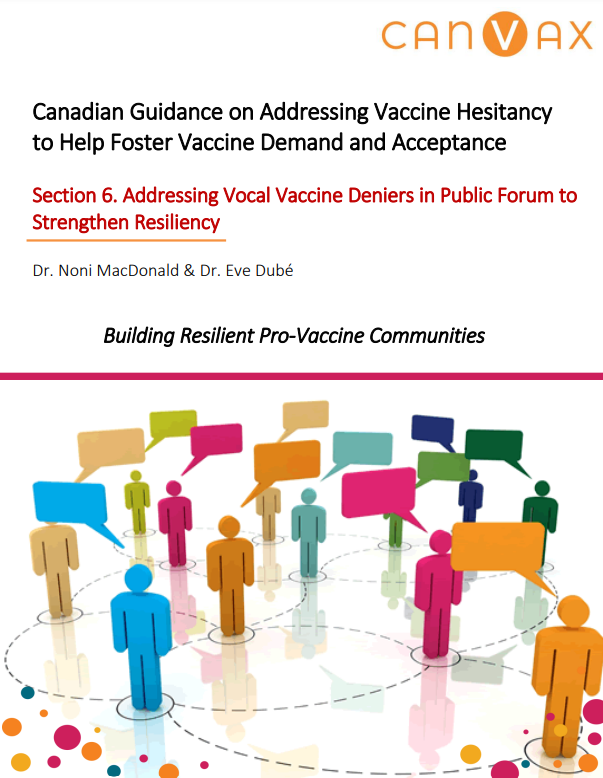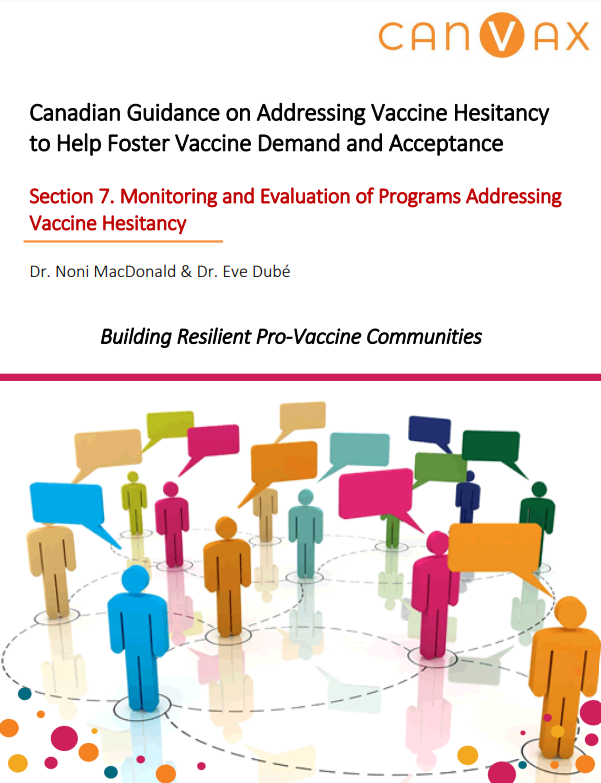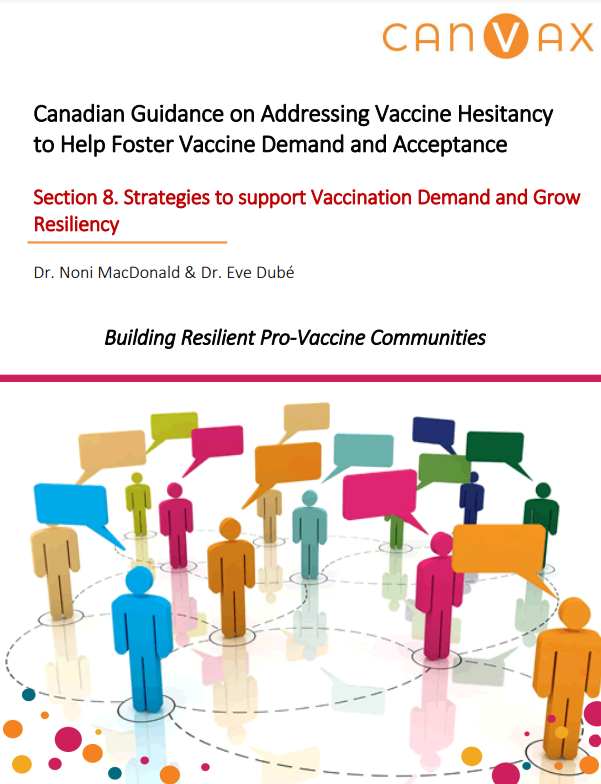Des guides
Un programme éducatif : Protéger les enfants contre l’influenza (la grippe)
Protéger les enfants contre l’influenza (la grippe) est un programme éducatif qui a été créé pour aider les parents et les tuteurs à protéger leurs enfants contre le virus de l’influenza. Cette video explique (1) ce qu’est la grippe, (2) comment la grippe affecte les enfants, (3) comment traiter la grippe, (4) le vaccin antigrippal et (5) propose d’autres mesures pour vous protéger contre la grippe. Parlez à votre médecin, votre infirmier/infirmière, votre pharmacien/ne ou votre bureau de santé publique pour faire vacciner votre enfant contre la grippe.
Aide-Mémoire : Surmonter l'hésitation vaccinale - Guide de référence rapide pour les professionnels de santé
Un guide de référence rapide pour les professionnels de santé pour sumonter l'hésitation à la vaccination
Aide-Mémoire : Surmonter l'hésitation vaccinale - Guide de référence rapide pour les gestionnaires de programmes de vaccination
Un guide de référence rapide pour les gestionnaires de programmes de vaccination pour surmonter l'hésitation à la vaccination
Tailoring Immunization Programmes (TIP): An evidence-based approach to enhance vaccine acceptance in Canada (en anglais seulement)
In this document, we briefly describe the TIP approach and its usefulness in the Canadian context. This is informed by the Guide for Tailoring Immunization Programmes document, which was developed in response to the recommendations of the evaluation of the TIP tool and approach in the European region.
Read more
Canadian Guidance on Addressing Vaccine Hesitancy to Help Foster Vaccine Demand and Acceptance - Full Report (en anglais seulement)
This document was adapted from the Western Pacific Regional Guidance on Addressing Vaccine Hesitancy to Help Foster Vaccine Demand document to address the Canadian context, and sections were updated.
Vaccine Hesitancy and Vaccine Demand: Definitions and Determinants (Section 1) (en anglais seulement)
"Vaccine hesitancy is complex and context specific, varying across time, place and vaccines. Vaccine hesitancy is influenced by factors such as complacency, constraints and confidence, and falls in the middle of the spectrum between strong vaccine demand and acceptance, and vaccine refusal and anti-vaccination."
Vaccine Hesitancy Globally and in Canada (Section 2) (en anglais seulement)
"Globally: Vaccine hesitancy has been reported in almost all countries globally. The most common reported reasons were risk-benefit (epidemiological and scientific evidence), lack of knowledge/awareness, and beliefs and attitudes. These reasons varied by income level, WHO region, by country and over time. In Canada: Vaccine hesitancy is well recognized across the country. The most common reasons fall into the confidence determinant category, but access, complacency and concerns about pain are also important."
Strategies to Detect Vaccine Hesitancy (Section 3) (en anglais seulement)
"Canada has been fortunate not to see the sharp and steep dips in vaccine acceptance for a specific vaccine that have been seen in several other high-income countries when vaccine scares have garnered much attention. However, periodic anti-HPV media stories have undermined efforts to build strong trust in the HPV vaccine. HPV vaccine acceptance rates are not uniformly over 90% across Canada."
Recognize and Diagnose Underlying Factors in Refusal or Delay in Vaccine Acceptance: The Guide to Tailoring Immunization Programmes TIP (Section 4) (en anglais seulement)
"Hesitancy is not uniform across a population. Analysis of vaccine uptake data from a province or territory may be able to detect subgroups with lower-than-expected coverage rates, given available vaccination services. Targeting these fence-sitters is an important component in addressing hesitancy to improve vaccine acceptance rates. Hesitant subgroups may be linked by a variety of factors, including geography, culture, socioeconomic and/or other factors, especially behavioural factors and determinants categorized by complacency, confidence and/or constraints."
Strategies to Address Hesitancy and Help Foster Demand (Section 5) (en anglais seulement)
"Vaccination decisions are complex. Hence it is not surprising that there is no single strategy that has been shown to be effective in addressing vaccine hesitancy in all circumstances. Many studies have focused on vaccine uptake and/or refusal in order to evaluate interventions aimed at enhancing vaccine acceptance. These studies have not captured whether the interventions changed doubts about acceptance – as the vaccine-hesitants are an important part of the population along the continuum of hesitancy."
Addressing Vocal Vaccine Deniers in Public Forum to Strengthen Resiliency (Section 6) (en anglais seulement)
"Social networks, geographic and online, provide an opportunity to explore diverse viewpoints or simply reflect or reinforce current (positive or negative) vaccine beliefs. The internet provides vocal vaccine deniers – the noisy, albeit relatively small, extreme end of the subgroup of vaccine refusers – with a potentially wide audience for their fringe views. Misinformation can further spread by social contagion and have a big impact on vaccine decisions. While the potential damage a vocal vaccine denier can cause through mass the media is significant, response from the immunization program must be approached carefully, thoughtfully and with caution. Poorly prepared or rash responses may backfire and further undermine pro-vaccine messaging."
Monitoring and Evaluation of Programs Addressing Vaccine Hesitancy (Section 7) (en anglais seulement)
"Vaccine hesitancy is a global problem affecting most countries, including Canada. However, the reasons for hesitancy vary. Vaccine hesitancy is changeable, varying by time, setting, vaccine and context.1 As vaccine hesitancy is unpredictable, monitoring for hesitancy and evaluating the outcomes of interventions is required so that provincial and territorial programs can track the degree of hesitancy, its impact on uptake in a population and in subgroups, and the effectiveness of their interventions to address hesitancy. This also needs to be tracked nationally to give a pan-Canadian perspective."
Strategies to support Vaccination Demand and Grow Resiliency (Section 8) (en anglais seulement)
"Strategic Objective 2 – the concept of demand – in the Global Vaccine Action Plan [GVAP] (approved by all countries at the World Health Assembly in 2012), pushes immunization program managers and partners to think beyond a continuum of hesitancy that ends with passive acceptance, towards a more comprehensive concept that includes the actions of individuals and communities to seek, support, and/or advocate for vaccination services. While addressing hesitancy can help increase vaccine uptake and acceptance, it does not necessarily lead to increased demand."


